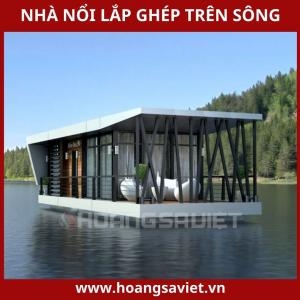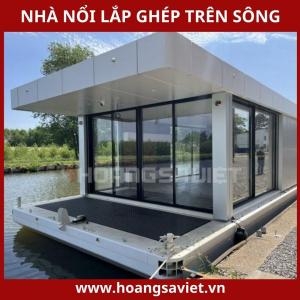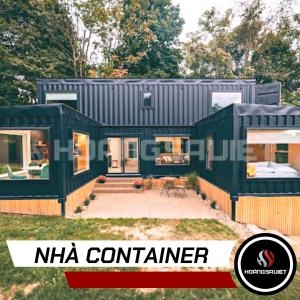The system is processing. Please wait a moment!
Vui lòng lựa chọn loại báo giá!
- Home Product prefab modular house
Prefabricated Floating House
- Model: Prefabricated floating house model
- Unit price: From 3.5 million/m2 optional area
- For 200 million , you can build a house from 48-60m2 (each floor is about 24-30m2)
- Option: Toilet, Wooden Floor, Decoration, Decor on request
- Shipping & Assembly: Actual Charges
- Brand: Hoang Sa Viet Construction
- Size: 36m2, 48m2, 64m2, 72m2...(1-2 bedrooms)
- Frame material: 2.5mm thick U160mm steel, tempered - electrostatic
- Wall material: 2-layer specialized 50mm panel
- Insulation capacity: 95%
- Fire resistance: 100%
- Connection Type: Smart Connector
- Electrical system included: Basic (LED lights, sockets, circuit breakers)
- Warranty: 10 Years
TABLE OF CONTENTS
- What is a prefabricated floating house?
- Where do prefabricated floating houses usually appear?
- Advantages of prefabricated floating houses?
- How to install and build a prefabricated floating house?
- Popular prefabricated floating house models in Vietnam
What is a prefabricated floating house?
A prefabricated floating house , also known as a boat house or a river house, is a type of house designed to float completely on water. The house consists of two main parts: the part that floats on the water and the part that is submerged below. The floating part is usually built from lightweight materials such as wood, corrugated iron, or plastic, while the bottom is fitted with buoys or thick foam to reduce pressure, ensuring that the house does not sink. This is the optimal solution for areas near rivers, lakes, or deep water.
SEE MORE ARTICLES
20 Latest Container House Models This Year
Check out the 50 most beautiful smart prefabricated house models!
Where do prefabricated floating houses usually appear?
Floating houses are a familiar construction model in low-lying areas that are often affected by flooding. In Vietnam, this type of house is most popular in the Mekong Delta, which is characterized by a dense river system and long rainy seasons that lead to annual flooding.
The prefabricated floating houses have the ability to automatically adjust their height according to the water level, helping people live safely when the water rises and return to their original position when the water recedes. In addition, the prefabricated floating houses are also mobile, suitable for the flexible living habits of people living in river areas.
Not only applied in the Southwest region, the prefabricated floating house model is also an effective solution for coastal areas in the Central region or areas vulnerable to climate change, providing optimal adaptation to harsh natural conditions.
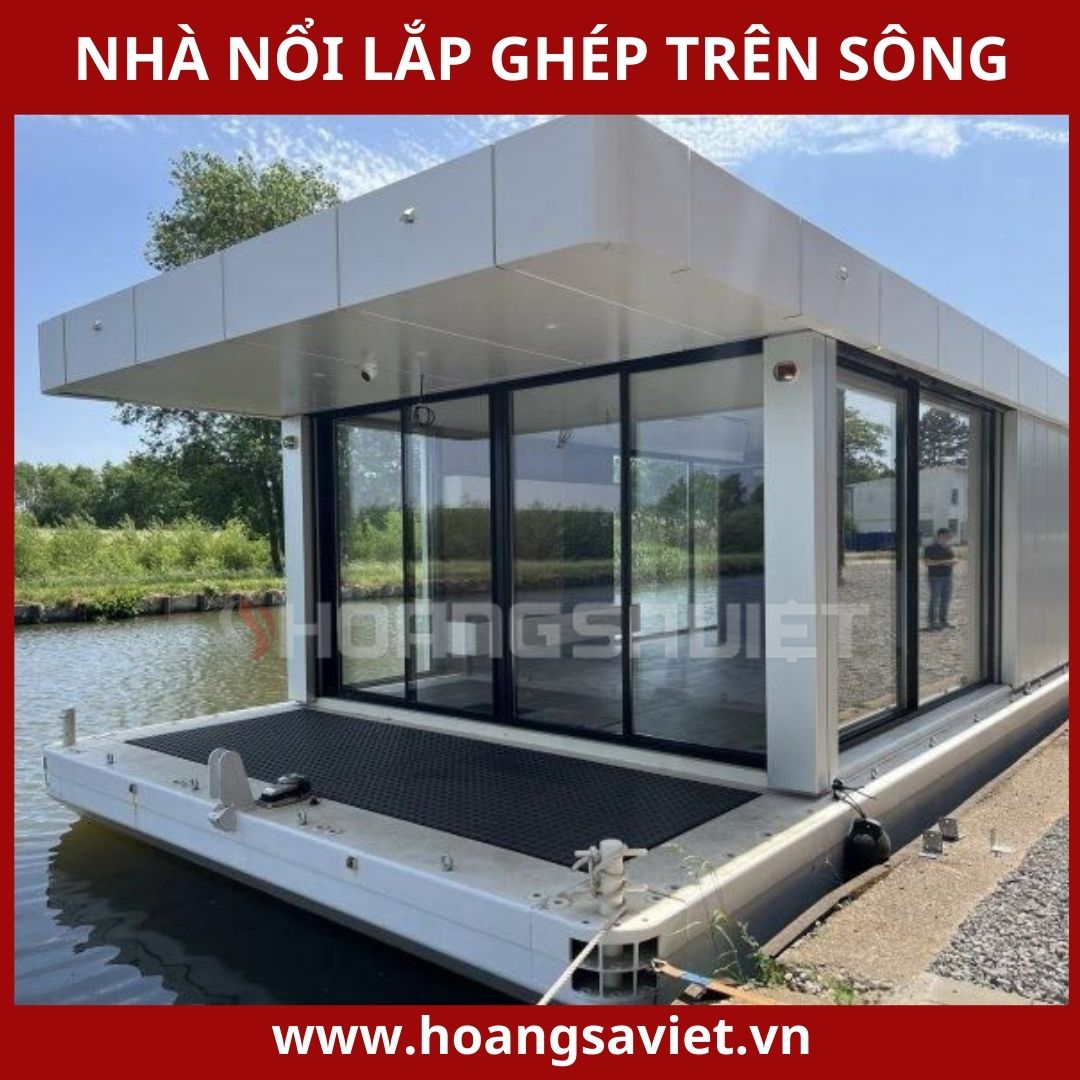
Advantages of prefabricated floating houses?
Prefabricated floating houses provide a modern and natural construction solution, especially in areas frequently affected by natural disasters and floods. Here are the specific reasons:
- Adaptability to flooding
The prefabricated floating house is designed to float on water, helping residents in flood-prone areas such as the Mekong Delta or Central Vietnam stay safe during the rainy season. This structure can automatically adjust its height according to the water level, ensuring uninterrupted daily activities.
2. Fast and cost-effective construction
With prefabricated design, floating houses reduce construction time and costs. Materials such as light steel, wood or plastic help reduce costs while ensuring long-term durability.
3. Easy to disassemble and move
Prefabricated floating houses can be flexibly relocated, meeting the needs of living or doing business in many different locations. This is a great advantage for areas that depend on rivers or flood seasons.

4. Environmentally friendly
The materials used are often lightweight and recyclable, helping to reduce negative impacts on the environment. This model is consistent with the trend of sustainable construction, limiting the exploitation of natural resources.
5. Diverse applications
Not only a place to live, prefabricated floating houses are also used as cafes, restaurants, homestays or resorts, creating a unique space that attracts tourists.
6. Solutions for climate change
Faced with climate change and rising sea levels, prefabricated floating houses are a viable solution, helping residents adapt to increasingly harsh natural conditions.
Floating houses are not only a safe and effective solution for flooded areas, but also provide economic, aesthetic and flexible use. This is a sustainable and creative construction model, in line with modern trends.
>>> Detailed price list for building prefabricated floating houses
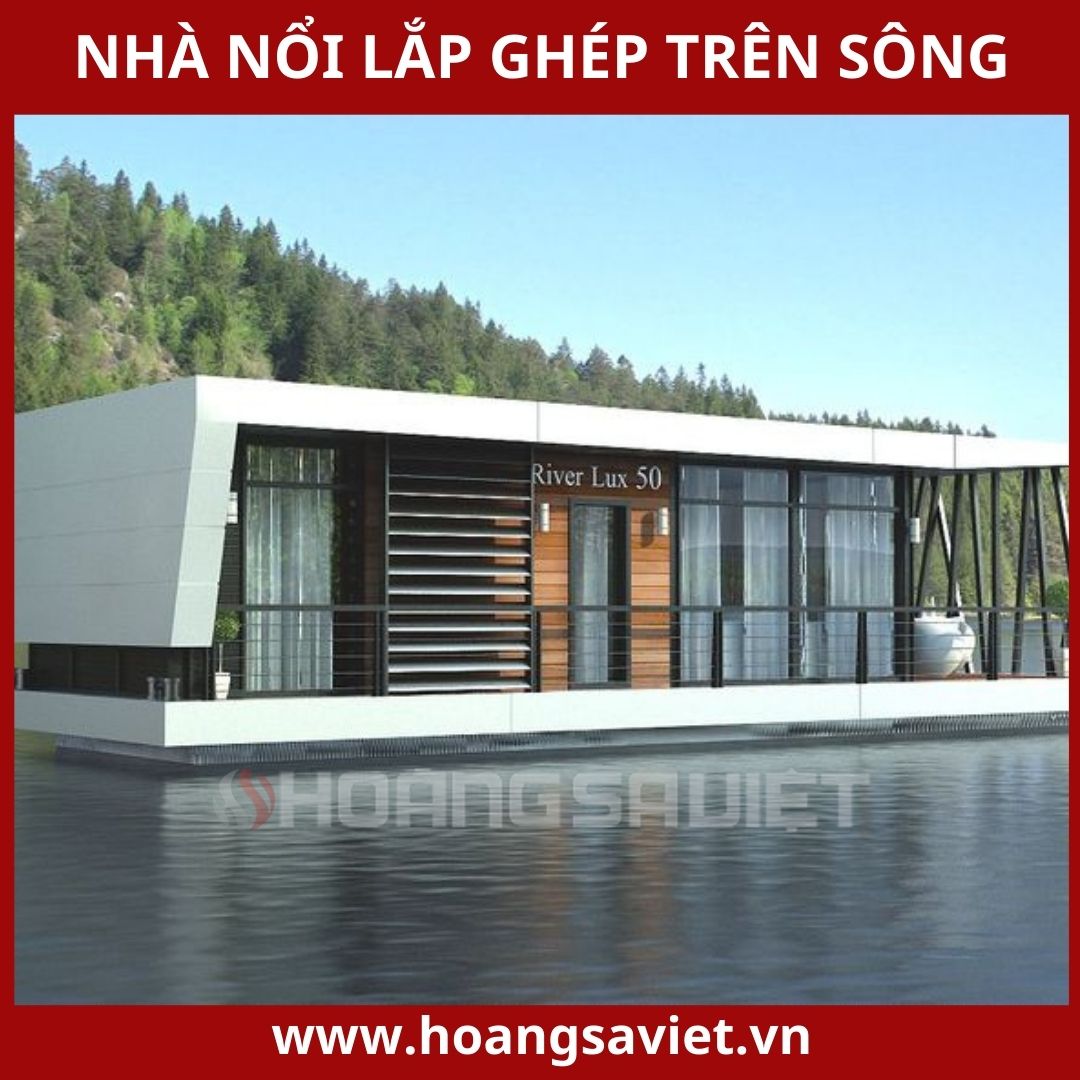
How to install and build a prefabricated floating house?
Prefabricated floating houses are a convenient and modern construction solution, especially suitable for flooded areas. To ensure safety, durability and aesthetics, the installation and construction process must comply with the following steps:
1. Prepare the site and materials
Topographic survey: Determine the water depth, flow conditions and water level stability. This helps in choosing the appropriate design.
Material selection: Use waterproof , lightweight, durable materials such as steel, wood, composite plastic and floating panels. These materials ensure the house has good buoyancy and load-bearing capacity.
Floating Plan: Use hard plastic, foam or hollow steel floats as a foundation to help the house float on the water.
2. Design and manufacture of components
Design drawings: Make detailed plans with house sizes and styles suitable for usage needs.
Component manufacturing: Parts such as steel frames , roofs, floors, and walls are manufactured at the factory to precise standards, ensuring easy assembly at the construction site.

3. Install the frame and floating floor
Fixing the floats: Place the floats under the floor position, connect them together with a steel frame to create stability.
Frame installation: Use galvanized steel or stainless steel frames to increase load-bearing capacity. Frame components are attached to the floating foundation through a sturdy bolt and bracket system.
4. Complete interior and exterior
Wall and roof installation: Use panels or lightweight materials to create a closed space inside the house. The roof can use cold-rolled steel, imitation tile steel or other insulating materials.
Interior equipment: Install waterproof floors, windows, doors and amenities such as kitchen, toilet to meet living needs.
Fixing system: Use anchor ropes or stakes to fix the house on the water surface, avoiding drifting when there is a strong current.
5. Periodic inspection and maintenance
Check buoyancy system: Make sure buoys or buoyancy materials are intact and not damaged.
Structural maintenance: Repair frames, walls and roofs when signs of rust or deterioration appear.
Adjust to water level: Check periodically to ensure the house does not tilt or lose balance on the water.
The installation of prefabricated floating houses is not only quick and economical, but also provides a safe solution for areas affected by flooding. With modern design, sustainable materials and precise construction processes, prefabricated floating houses are increasingly widely used. This is an ideal choice for the trend of sustainable construction and adaptation to climate change.
.jpg)
.jpg)
SEE MORE ARTICLES
20 Latest Container House Models This Year
Check out the 50 most beautiful smart prefabricated house models!
Popular prefabricated floating house models in Vietnam
Prefabricated floating houses are becoming a modern construction trend in Vietnam thanks to their flexibility, cost savings and ability to adapt to natural conditions. Below are popular prefabricated floating house models:
1. Floating house assembled as a civil house
Characteristic:
This model is designed for long-term living in areas that are frequently flooded such as the Mekong Delta.
The floating part uses plastic buoys or drums to keep balance.
The house frame is made of steel or wood, the roof is usually made of corrugated iron or insulating material.
Application: Suitable for households in the Western region, where there is a dense canal system.
.jpg)


2. Prefabricated floating house for ecotourism
Characteristic:
Designed with natural architecture, often combining materials such as natural wood, bamboo, and thatched roofs.
Open space, river view balcony, minimalist but sophisticated interior.
Equipped with additional solar energy and wastewater treatment systems.
Application: Homestays, floating resorts in the West or lakeside in the Central Highlands.
.jpg)
.jpg)
.jpg)
3. Prefabricated floating house used as a cafe or restaurant
Characteristic:
Unique design with open space, combining modern and traditional style.
Can be installed on rivers, lakes, or large ponds to create a focal point to attract customers.
Application: F&B business, especially suitable in tourist areas or places with river views.
.jpg)
.jpg)


4. Prefabricated floating houses for public works
Characteristic:
Flexible structure, can be disassembled and moved when needed.
Serves as a floating classroom, floating medical station, or office in flooded areas.
Application: Supporting communities in areas frequently affected by natural disasters.

5. Prefabricated floating houses for entertainment and recreation
Characteristic:
Diverse designs, often integrating playground areas, floating pools, and entertainment spaces on the water.
Use anti-slip material and ensure high safety.
Application: Organizing amusement parks or water sports centers at large lakes.
.jpg)
The prefabricated floating house models are not only diverse in design but also suitable for many different purposes. From housing, business to public works, this model is increasingly proving its applicability and effectiveness in the typical river conditions in Vietnam. This is a sustainable construction solution and suitable for modern trends.
SEE MORE ARTICLES
20 Latest Container House Models This Year
Check out the 50 most beautiful smart prefabricated house models!
Hiện chưa có đánh giá nào về sản phẩm này!









